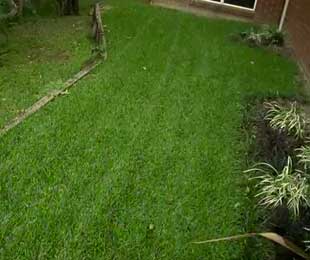There are things that can be done to improve shade tolerance of lawns. Firstly mow high, at around 50 to 60 mm in shady spots. Fertilise well at least 4 times per year with slow release fertiliser, and prune trees and shrubs to increase light penetration.
Trees suck out water, so irrigate more under trees, but also ensure there is adequate drainage, as wet shade really hurts turf. And finally, make sure the ground is not too compacted, by aerating every couple of years.

Soft Leaf Buffalo is the best all-round shade grass for Australia, but beware of false and exaggerated claims. In the USA Buffalo is known as St Augustine. Research at the Department of Primary industries shows Buffalo at best can cope with 60% shade and stay healthy for general turf areas, including moderate wear.
With low wear and good maintenance, and the right variety you could push it to 70% shade. In high wear areas such as for big dogs, the most you can hope for is 50%. Some growers make outrages claims of 85%: beware of such claims, as it flies in the face of independent research. Buffalo is also good for full sun.
If you have more than 70% shade, use a Liriope turf such as Isabella, a mow once per year lawn alternative, that is ideal for planting around stepping stones. The best Buffalo in the independent research was Sapphire Buffalo. Zoysia turf is the next best in shade, coping well with 40% shade for wear areas, and 50% shade for low wear areas. Couch and Kikuyu only cope with a maximum of 20% shade. With proper care, and the right grass selection, you can grow turf well in shady yards.
Lawn for wet feet, drainage channels, and erosion control
Finding lawns that cope with wet feet used to be difficult, but that was before Empire Zoysia and Nara Native Turf. Naturally it’s better to improve drainage, by using agg pipe, improve the soil by adding free draining material, or raising the level, but sometimes that’s not possible.
It maybe a low lying area, or a place that gets too much run off in rain events, a bioretention basin or rain garden, or simply a wet part of a yard. Turf farmers know well how Empire Zoysia turf is one of the least damaged by floods, surviving well in the Queensland floods a few years back. Nara Native turf is now widely used in drainage channels by councils and mining sites.
So whether it’s a regularly bogy site at home, or a periodically inundated commercial site, these grasses are the best choice. They are particularly good for roadside drainage channels. Using E-Staples the Nara Native turf and Empire can be secured strongly, without the need for netting.
The turf rolls are far stronger than couch and Kikuyu. In tests the turf withstood 2 metres per second flows straight after installation. Much better than Kikuyu, Couch and Buffalo that rot in regular wet feet. It is recommended that the site dry’s out occasionally. If the site is wet and saturated for every day of the year, it will probably be too much for even these turf types, but half and half, they work well. Best of all, Empire and Nara are extremely drought tolerant, and make great low maintenance home and commercial lawns.
What’s the best low maintenance lawn for your yard?
In warm climates such as Australia, and southern USA, this is widely agreed upon to be Zoysia. Research in Australia and the USA has shown Zoysia needs less mowing, less edging, and less water than other home lawns. Extensive research shows Zoysia is more drought tolerant than Buffalo (St Augustine in the USA).
Zoysia is very tolerant of herbicides, but it also is one of the best lawns at out competing weeds through natural competition. Zoysia also is more lawn grub resistant compared to Couch, Kikuyu and Buffalo, but remember Zoysia is not quite as shade tolerant as Buffalo, but can still handle up to 50% shade. For higher shade areas, Buffalo is the lowest maintenance grass.
Some Zoysia types, like matrella and tenuifolia, although needing less mowing, do become very thatchy, or spongy. In warm climates, this means once thatch they brown of quickly, and scalp badly after mowing. It is much better to use non thatch types. There are two types that stand out, Empire Zoysia and Nara Native Zoysia, both low thatch types. Empire needs very little fertiliser, but does have better winter colour if fertilised in Autumn.
Nara has incredible winter colour compared to other Zoysia types, so with and autumn and winter fertilise, it will stay green all year round in most regions. Kikuyu is very fast growing, but is good for dogs, and couch grows rapidly, and also scalps badly when mown. So for heavy shade use Buffalo, and everywhere else use Zoysia if you want a low maintenance lawn.
<< Back to Articles Home Page Turf & Lawn Information Articles Maintenance Articles Full List of Articles
